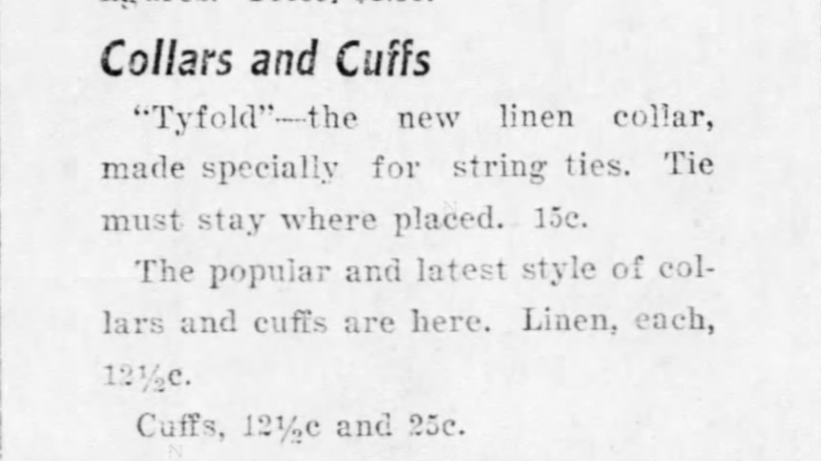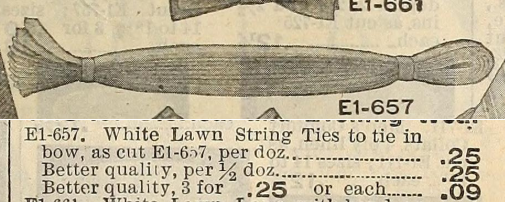Collar Oddities
- RJW Shirts

- Jan 24, 2019
- 4 min read
Updated: Jan 25, 2019
It has been nearly 200 years since detachable collars were invented in Troy, New York. Through the centuries 10's of Thousands of individual collars designs have come and gone in the hopes of attracting the collar wearing citizen - most of which were only slightly different than the one before it.
Occasionally, in a sea of design sameness, a collar came along that stuck out from the rest. A clever collar designer could capture the imagination of the observer and it could mean the difference between the success or failure of a collar on the market. But how much cleverness is too much? And does it always win the day?
This is a list of some of those stand-out collars.
My glossary of neckwear listed in this post can be found HERE
A Quick Note Regarding Collar Company Tactics....
It was commonplace practice for companies to offer one collar design in several different heights and qualities. Often, but not always, collar companies gave each height a new name.
Example: Cluett, Peabody & Co., collars not only offered a same design collar in different heights (each height with different names), they also offered different quality fabric options: "Cluett brand" being the better quality product; "Arrow brand" being the poorer quality product. Quality of collar brands relied on two main factors: 1. Quality of fabrics used; and 2. Layers of fabrics used, sometimes called "ply" or "fold" (the more fabric layers, the more layers for starch to adhere to and make a stiffer collar). This tactic also presented collars at different prices. The "Arrow" name was advertised as the poorer quality collar between the 1890's to approx 1927 - something that came back to haunt the Arrow brand when they reformed their entire business in 1929.
Nevertheless, some entries in this post will show collar adverts with different names for the same collar. And a search for collar adverts will soon lead to some confusion as to why so many collars of the same design appear to be named differently.
The "Tyfold" Collar.

The "Tyfold" Collar was released in March, 1903 by Cluett, Peabody & Co., Inc. The principal design features a circular cut out section on the collar's front tie edges. The hole allowed the collar's front edges to meet parallel even when the neckwear was placed between the edges. The Tyfold measured 1 7/8" at the centre-back and 2 1/8" at the centre-front and was stiffly starched and never offered as a soft version.


Adverts described the Tyfold in the following way: "A patented invisible tie-hold opening keeps the tie in place; it cannot slip up or down or from side to side; you don't see the opening when the tie is adjusted.".

As clever as this collar seemed, the types of neckwear that effectively worked with it was restricted. Thinner, lighter types of neck ties and cravats were needed. Various adverts suggested types of designs which would work along with the Tyfold: "String tie" (a thin bow tie, usually 3/4" wide) and "Midget string tie" (a string tie with 5/8" width neck strap), for example.
Some adverts from 1903 showed the Tyfold paired with some sort of Flowing End/Batwing type scarf.
Unlike many other Cluett, Peabody & Co., collars, the Tyfold had a short life in the USA. The collar was tricky and not very accommodating to the majority of larger neckwear on the market. Advertising only lasted from March 1903 to May 1904. In 1904 Cluett sent the remaining Tyfold stock to the UK. It was the first collar the company offered to the British - they didn't just take out the trash, they exported it to another country. Perhaps it was more suitable to British tastes.
The "Gothic" collar.
On September 22nd, 1915 - 12 years after Cluett, Peabody & Co., released their short-lived "Tyfold" collar - they introduced the "Gothic" collar. The Gothic's front opening was formed with an outward curve each side to allow the neackwear to sit inside it without stressing the collar's tie gap open. It measured 2 1/8" at the centre-back and centre-front and was starched stiff and never offered in a soft version.
While I strive not to speculate without evidence, it seems the Gothic collar was possibly Cluett's 2.0 version of their previous Tyfold. Advertisements took great care to mention that the Gothic collar "is formed to fit and hold the cravat knot. No matter what style of cravat is worn." - something the Tyfold collar could never boast.
Some adverts claimed it could be paired with bow ties and four-in-hand ties.

Well received, the Gothic could be seen in adverts of other garment businesses.

Advertising for the Gothic spanned from 1915 to 1917.
The "Security", "Attachee" & "Equity" collars.
In 1901, Wilbur, Campbell, Stephens Co., aka "Wilbur's", introduced a collar onto the USA market sometimes referred to as the "Buttonhole Collar".
The design simply employs a turned-down collar with vertical button holes stitched either side of the front tie gap edges. The concept allows neckwear to pass through buttonholes rather than the centre-front opening . Wilbur's also boasted a string of collar designs that were "Double Wear" - which meant the collar could be turned to either side during the starching process. Reversing a collar to the other side was common practice for starching laundries (mostly due to wear on the fabric on one side). Wilbur's took this one step further by either stamping their labels etc on both side of turned-down collar, or only stamping the very lower edge on Double Wear stand collars so that the stamps will be hidden by the neckstrap of neckwear.

The collar was offered in 3 heights: "Equity 2 1/2"", "Attachee 2 3/4"" and "Security 3"". The "Security" advertised below, stated that the collar was designed to be worn with a "Batwing Bow" or "Batwing Tie" - both of which were purpose made by Gault Brothers' Neckwear.


Dating advertising for Wilbur's collars is difficult. Wilbur's preferred magazine adverts instead of newspaper inserts, making it tricky to source the end date of advertising for this collar.





























Comments